BullsEye
 A body A is dropped froma a height
above the ground. At the same time another body B at a distance
from the projection of A from the ground is fired at an angle
to the horizontal. If the two collide at the maximum point of the trajectory of B the angle of the projection is given by
A body A is dropped froma a height
above the ground. At the same time another body B at a distance
from the projection of A from the ground is fired at an angle
to the horizontal. If the two collide at the maximum point of the trajectory of B the angle of the projection is given by
(A)
(B)
(C)
(D)
This section requires Javascript.
You are seeing this because something didn't load right. We suggest you, (a) try
refreshing the page, (b) enabling javascript if it is disabled on your browser and,
finally, (c)
loading the
non-javascript version of this page
. We're sorry about the hassle.

x -axis movement
V 0 cos α t = d
y -axis movement
h − x is the height at the maximum point of the projection
From body A until h − x height
h − x = h − 4 . 9 t 2
− x = − 4 . 9 t 2
From body B until h − x height
h − x = V 0 sin α t − 4 . 9 t 2
Then
h − x = V 0 sin α t − x
h = V 0 sin α t
Finally
V 0 cos α t V 0 sin α t = d h ⇒ tan α = d h ∴ α = tan − 1 ( d h )